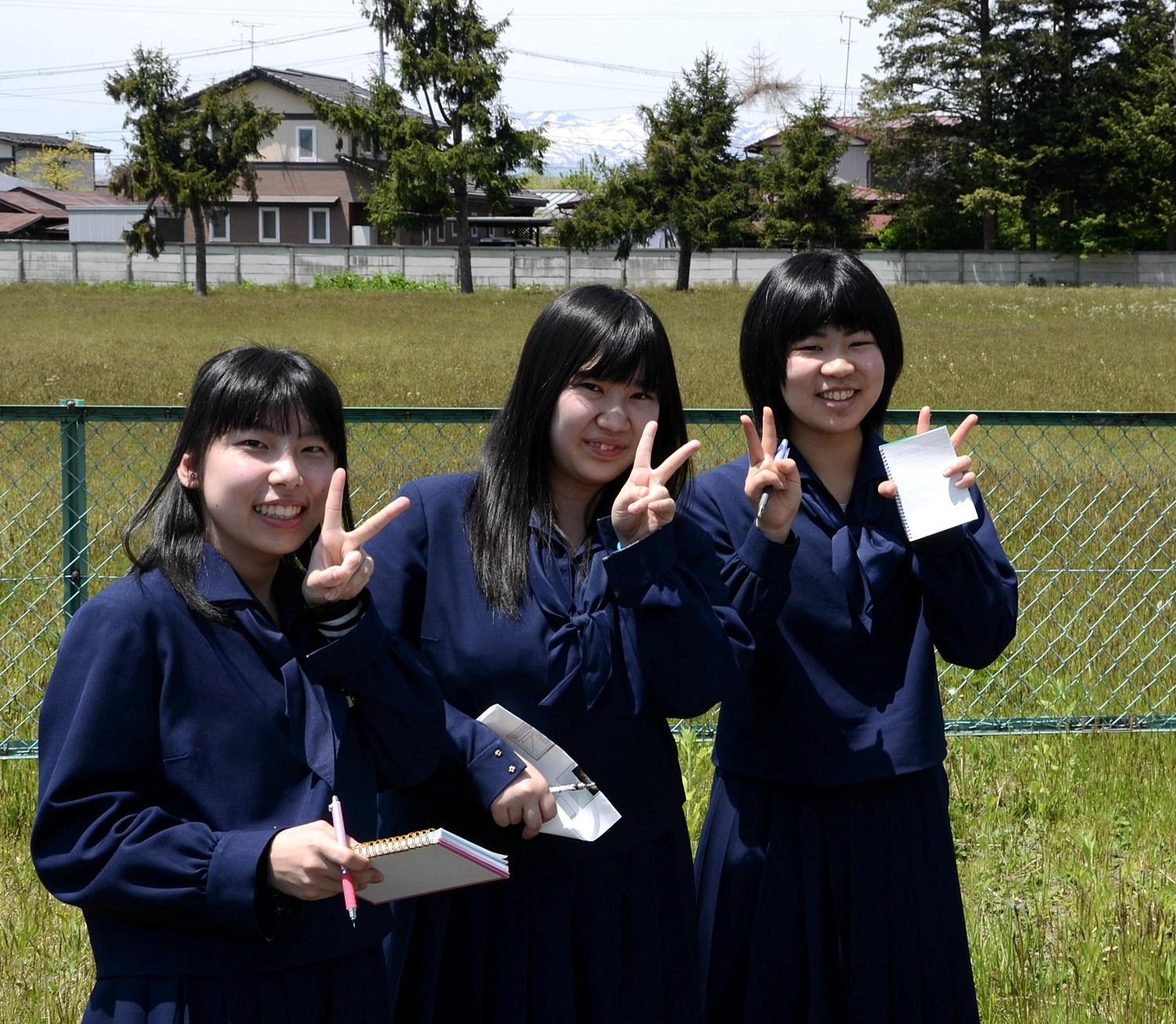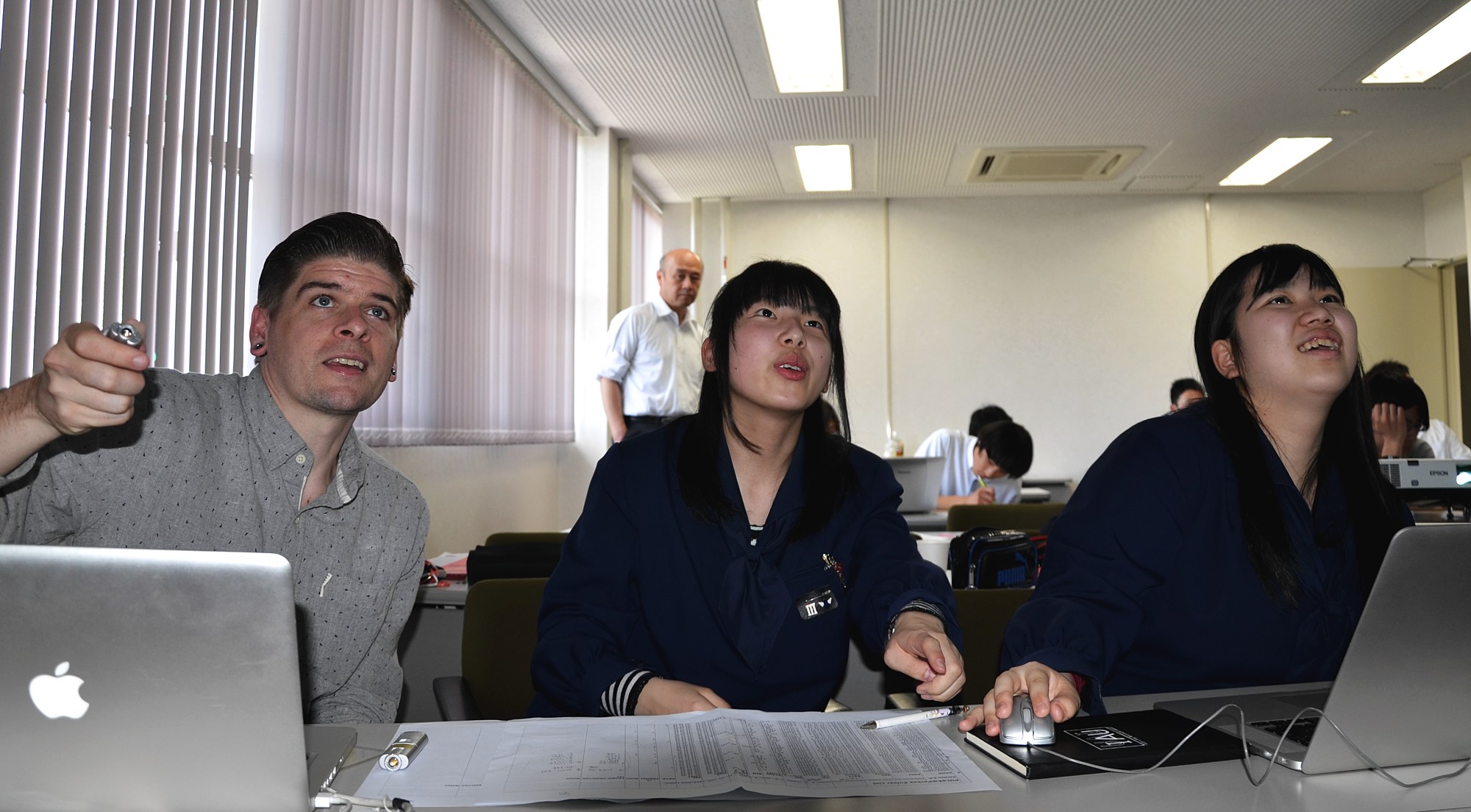PULSE@Parkes is an innovative program run by CSIRO Astronomy and Space Science that gives high school students the opportunity to control the iconic 64m Parkes radio telescope remotely in real time to observe pulsars then analyse the data. Currently two of the project team, coordinator Robert Hollow and pulsar astronomer Dr Ryan Shannon are in Japan on the PULSE@Parkes in Japan tour.
Over two weeks they are visiting a number of astronomy and space-related instituions and conducting four hands-on observing sessions with the Parkes dish for Japanese high school students. The first two observing sessions were held last weekend at the NAOJ Mizusawa VLBI Observatory in Iwate Prefecture, a three hour Shinkansen ride north of Tokyo. During the weekend students from four high schools visited for a full day of activities.
Students from Morioka 3rd High School at Mizusawa, happy to be taking part in PULSE@Parkes.
Students from Morioka 3rd High School at Mizusawa, happy to be taking part in PULSE@Parkes.
NAOJ astronomer Dr Osamu Kameya, our host and coordinator of the tour in Japan, gave the students an introduction to radio astronomy and background theory (in Japanese). Following this we all toured the Mizusawa site, including the 20m VERA radio telescope. After this Robert Hollow gave the preparatory talk about PULSE@Parkes to the students in English. Fortunately Kameya-san had prepared Japanese subtitles for this talk and the students were very patient in trying to understand it. Following a brief lunch break it was time to control the telescope!
Students in front of the VERA radio telescope.
Students in front of the VERA radio telescope.
Students controlled the dish in groups of two or three. Each group observed a couple of pulsars, determining which ones would be visible then using the telescope control software to drive the dish to the source. After gathering data they moved to the back of the room to analyse their data using the newly-released online module to determine the distance to their pulsars. This module is open for anyone to use via a web browser. You too can go and analyse the data from these or any previous PULSE@Parkes sessions. Some of the students were quite competitive to see who could find the most distant pulsar.
Dr Ryan Shannon with students controlling the Dish
Dr Ryan Shannon with students controlling the Dish
During the session Ryan was able to explain why pulsars are such fascinating object to observe and what are some of the problems we are still trying to solve. The accompanying Japanese teachers were also able to view the program in action get involved. The students became more confident in talking with us in English, asking questions about astronomy and Australia. Their English was certainly much better than our Japanese. As with all PULSE@Parkes sessions we discussed what we were doing via twitter (@PULSEatParkes) whilst a live data stream and webcam view of the telescope can be viewed via a web browser using the Parkes Pulsar Online Monitor.
Students from the first session at NAOJ Mizusawa VLBI Observatory
Students from the first session at NAOJ Mizusawa VLBI Observatory
Following the Saturday session Kameya-san drove us for one and half hours down to the coastal region devastated by the recent earthquake and tsunami. This was a very sobering experience for us, walking across the flat land, now mostly cleared of debris from the houses demolished by the tsunami. Two of the students had travelled from another devastated coastal town five hours from Mizusawa to take part in the session. Many students at the participating schools had lost family and friends in the tsunami.
Some of the tsunami devastation at the coastal town of Rikuzentakata
Some of the tsunami devastation at the coastal town of Rikuzentakata
The tour is supported by a grant from the Australia-Japan Foundation with the aims of
- increasing the understanding in Japan of shared interests with Australia
- increasing recognition in Japan of Australian excellence and expertise within the theme of Science and Education
The Foundation was keen for us to focus our tour on the earthquake and tsunami affected regions so were were thankful for the opportunity to visit Mizusawa. Next weekend students will be observing at Koriyama Space Park in Fukushima Prefecture. Join us on twitter to take part.
CASS is grateful for the generous support of the Australia-Japan Foundation for this tour. We would also like to acknowledge the effort of NAOJ and Dr Kameya in particular in hosting and organising the tour. Schools that observed on the 18 and 19 May were: Mizusawa High School, Morioka 3rd High School, Ichinoseki National College of Technology and Miyako Suisan High School.







Pingback: PULSE@Parkes@Parkes with Parkes | Universe @ CSIRO
Pingback: PULSE@Parkes in Japan Part 2. | Universe @ CSIRO